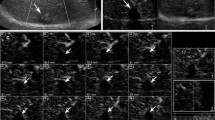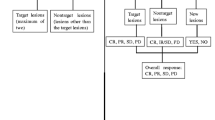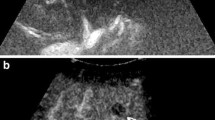Abstract
We evaluated the ability of one-month follow-up contrast-enhanced ultrasound (CEUS) with second-generation contrast agent in monitoring radio frequency ablation (RFA) and transcatheter arterial chemoembolization (TACE) treatments of hepatocellular carcinoma (HCC). One-hundred forty-eight HCCs were studied using CEUS: 110 nodules were treated with RFA [41/110 RFA were performed using a pretreatment and an immediate postablation evaluation using CEUS (group 1); 69/110 using only US guidance (group 2)] and 38 nodules treated with TACE. For statistical analysis, McNemar test was used. Overall complete response was observed in 107/148 nodules (92/110 treated with RFA and 15/38 with TACE). A better rate of complete response was found in group 1 compared to group 2 (92.7% vs. 78.3%). In RFA treatment, CEUS showed a sensitivity of 83.3% and a specificity of 100% (diagnostic accuracy of 97%) using MDCT as reference standard with no statistical difference (p > 0.05). CEUS detected all cases of incomplete response in HCC treated with TACE using angiography as reference standard (diagnostic accuracy 100%). We recommend assessing residual intratumoral flow on CEUS during RFA procedure to determine the necessity of immediate additional treatment. In case of positive CEUS results, HCC treated with TACE should be considered still viable.





Similar content being viewed by others
References
Bruix J, Sherman M, Llovet JM, et al. (2001) Clinical management of hepatocellular carcinoma Conclusions of the Barcelona-2000 EASL conference. J Hepatol 35:421-430
Lau W (2003). Future perspectives for hepatocellular carcinoma. HPB 5(4):206-213
Kim SH, Lee WJ, Lim HK, et al. (2007) Prediction of viable tumor in hepatocellular carcinoma treated with transcatheter arterial chemoembolization: usefulness of attenuation value measurement at quadruple-phase helical computed tomography. J Comput Assist Tomogr 31(2):198-203
Choi H, Loyer EM, DuBrow RA, et al. (2001) Radio-frequency ablation of liver tumors: assessment of therapeutic response and complications. Radiographics 21 Spec No:S41-54
Park MH, Rhim H, Kim YS, et al. (2008) Spectrum of CT findings after radiofrequency ablation of hepatic tumors. Radiographics 28(2):379-390
Kim CK, Choi D, Lim HK, et al. (2005) Therapeutic response assessment of percutaneous radiofrequency ablation for hepatocellular carcinoma: utility of contrast-enhanced agent detection imaging. Eur J Radiol 56:66-73
Ding H, Kudo M, Onda H, et al. (2001) Evaluation of Posttreatment Response of Hepatocellular carcinoma with Contrast-enhanced Coded Phase-Inversion Harmonic US: Comparison with Dynamic CT. Radiology 221:721-730
Choi D, Lim HK, Kim SH, et al. (2000) Hepatocellular carcinoma treated with percutaneous radio-frequency ablation: usefulness of power Doppler US with a microbubble contrast agent in evaluating therapeutic response-preliminary results. Radiology 217:558-563
Meloni MF, Goldberg SN, Livraghi T, et al. (2001) Hepatocellular carcinoma treated with radiofrequency ablation: comparison of pulse inversion contrast-enhanced harmonic sonography, contrast-enhanced power-Doppler sonography, and helical CT. AJR Am J Roentgenol 177:375-380
Lencioni R. (2006) Impact of European Federation of Societies for Ultrasound in Medicine and Biology (EFSUMB) guidelines on the use of contrast agents in liver ultrasound. Eur Radiol 16(7):1610-1613
Leen E, Ceccotti P, Kalogeropoulou C, et al. (2006) Prospective multicenter trial evaluating a novel method of characterizing focal liver lesions using contrast-enhanced sonography. AJR Am J Roentgenol 186(6):1551-1559
Solbiati L, Ierace T, Tonolini M et al. (2004) Guidance and monitoring of radiofrequency liver tumor ablation with contrast-enhanced ultrasound. Eur J Radiol 51:S19-23
Giovannini M, Moutardier V, Danisi C, et al. (2003) Treatment of hepatocellular carcinoma using percutaneous radiofrequency thermoablation: results and outcomes in 56 patients. J Gastrointest Surg 7(6):791-796
Cammà C, Di Marco V, Orlando et al. (2005)Treatment of hepatocellular carcinoma in compensated cirrhosis with radio-frequency thermal ablation (RFTA): a prospective study. J Hepatol 42(4):535-540
Lin SM, Lin CJ, Lin CC, et al. (2005) Randomised controlled trial comparing percutaneous radiofrequency thermal ablation, percutaneous ethanol injection, and percutaneous acetic acid injection to treat hepatocellular carcinoma of 3 cm or less. Gut 54(8):1151-1156
Lin SM, Lin CJ, Lin CC, et al. (2004) Radiofrequency ablation improves prognosis compared with ethanol injection for hepatocellular carcinoma ≤ 4 cm. Gastroenterology 127(6):1714-1723
Keiji Hayashi, Hiroyasu Ina, Mikio Tezuka, et. al. (2007) Local Therapeutic Results of Computed Tomography-Guided Transcatheter Arterial Chemoembolization for Hepatocellular Carcinoma: Results of 265 Tumors in 79 Patients. Cardiovasc Intervent Radiol 30:1144–1155
T Murakami, H Ishimaru, I Sakamoto, et al. (2007) Percutaneous radiofrequency ablation and transcatheter arterial chemoembolization for hypervascular hepatocellular carcinoma: rate and risk factors for local recurrence. Cardiovasc Intervent Radiol 30:696-704
Miraglia R, Pietrosi G, Maruzzelli L, et al. (2007) Efficacy of transcatheter embolization/chemoembolization (TAE/TACE) for the treatment of single hepatocellular carcinoma. World J Gastroenterol 13(21):2952–2955
Dill-Macky MJ, Asch M, Burns P, Wilson S. (2006) Radiofrequency ablation of hepatocellular carcinoma: predicting success using contrast-enhanced sonography. AJR Am J Roentgenol 186:S287-295
Lu DS, Yu NC, Raman SS, et al. (2005) Radiofrequency ablation of hepatocellular carcinoma: treatment success as defined by histologic examination of the explanted liver. Radiology 234(3):954-960
Lee JK, Chung YH, Song BC, et al. (2002) Recurrences of hepatocellular carcinoma following initial remission by transcatheter arterial chemoembolization. J Gastroenterol Hepatol. 17(1):52-58
Author information
Authors and Affiliations
Corresponding author
Rights and permissions
About this article
Cite this article
Salvaggio, G., Campisi, A., Lo Greco, V. et al. Evaluation of posttreatment response of hepatocellular carcinoma: comparison of ultrasonography with second-generation ultrasound contrast agent and multidetector CT. Abdom Imaging 35, 447–453 (2010). https://doi.org/10.1007/s00261-009-9551-6
Received:
Accepted:
Published:
Issue Date:
DOI: https://doi.org/10.1007/s00261-009-9551-6




